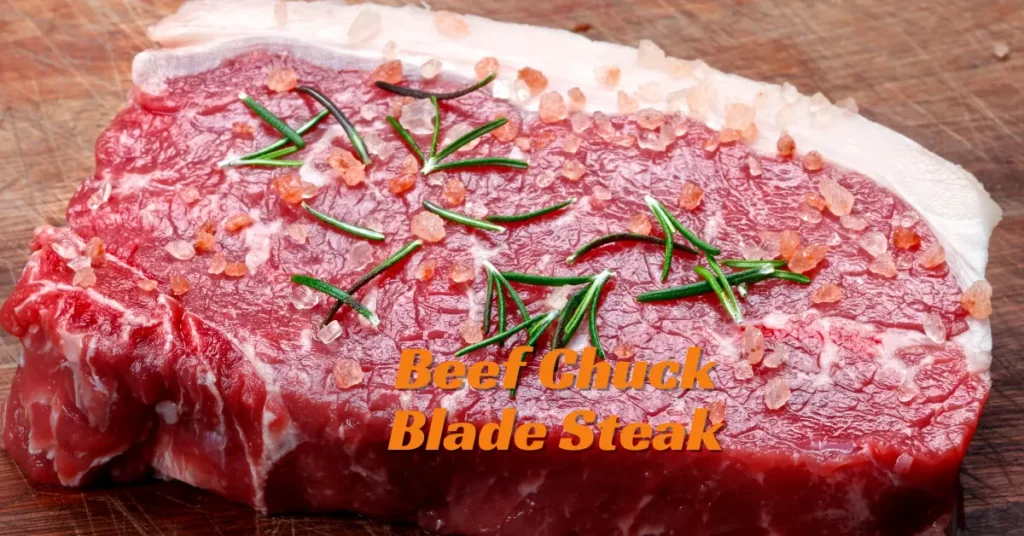This post may contain affiliate links. If you use these links to buy something we may earn a small commission. Thanks.
Beef chuck blade steak may not have the instant appeal of a ribeye or filet mignon, but don’t let that fool you this humble cut is a hidden gem. Packed with deep, beefy flavor and budget-friendly, it has enormous potential when treated right. With the right preparation and cooking method, chuck blade steak transforms into a tender, mouthwatering dish you’ll want to cook again and again.
In this guide, you’ll learn everything you need to know to cook beef chuck blade steak to perfection, including preparation tips, multiple cooking methods, and expert advice for serving and storage.
What is Beef Chuck Blade Steak?
Beef chuck blade steak comes from the chuck primal, which is located near the shoulder area of the cow. This section sees a lot of movement, resulting in a cut that’s flavorful but can be tough due to connective tissue.
Often referred to as “blade steak,” this cut can sometimes be confused with others like flat iron or chuck eye steak. However, it typically contains a line of gristle running through the center, making it less ideal for quick grilling unless properly marinated or tenderized.
Despite this, when cooked properly, chuck blade steak becomes incredibly flavorful and surprisingly tender.

Preparing the Steak for Cooking
Before you dive into cooking, the preparation process is key to ensuring a successful outcome.
1. Trimming
Start by trimming any excess fat or silver skin from the edges. This isn’t always necessary, but it can help improve the texture and overall eating experience.
2. Pat Dry
Always pat the steak dry with paper towels before seasoning. A dry surface helps achieve a better sear and crust.
3. Seasoning Options
Depending on your chosen cooking method, you can go the simple route or build layers of flavor:
- Basic Seasoning: Salt, pepper, and a touch of garlic powder.
- Dry Rub: Use spices like paprika, onion powder, thyme, and cayenne for a smoky, savory flavor.
- Marinades: For grilling or pan-searing, a marinade with acidic ingredients like lemon juice, vinegar, or buttermilk can help break down tough fibers.
Let the steak sit at room temperature for about 30 minutes after seasoning. This promotes even cooking.
Cooking Methods for Chuck Blade Steak
There’s no one-size-fits-all method for cooking this cut. The best approach depends on your time, tools, and taste preferences. Here are the most reliable methods:
Method 1: Braised Chuck Blade Steak (Best for Tenderness)
This is arguably the best way to cook chuck blade steak, especially if tenderness is your priority.
Ingredients:
- 2 beef chuck blade steaks
- 2 tablespoons oil (vegetable or olive)
- 1 onion, chopped
- 3 cloves garlic, minced
- 2 cups beef broth
- 1/2 cup red wine (optional)
- 2 bay leaves
- 1 teaspoon dried thyme
- Salt and pepper to taste
Instructions:
- Preheat a large skillet or Dutch oven over medium-high heat. Add oil.
- Sear the steaks for 2–3 minutes on each side until browned.
- Remove the steaks and set aside. In the same pan, sauté onion and garlic until fragrant.
- Deglaze with wine (if using), scraping up the browned bits.
- Add broth, bay leaves, thyme, salt, and pepper.
- Return steaks to the pan. Cover and reduce heat to low.
- Simmer gently for 2.5 to 3 hours, turning occasionally, until fork-tender.
Serving Ideas:
Pair with mashed potatoes, roasted carrots, or crusty bread to soak up the flavorful braising liquid.
Method 2: Grilled Chuck Blade Steak (With Marinade)
While grilling isn’t the most common method, it can work well with proper marination.
Marinade Ingredients:
- 1/4 cup olive oil
- 2 tablespoons soy sauce
- 2 tablespoons red wine vinegar
- 1 teaspoon Dijon mustard
- 1 teaspoon garlic powder
- 1/2 teaspoon black pepper
Instructions:
- Combine marinade ingredients and pour over the steak. Cover and refrigerate for at least 6 hours or overnight.
- Preheat your grill to medium-high heat.
- Remove steak from marinade and let excess drip off.
- Grill for 5–6 minutes per side, depending on thickness. Aim for an internal temperature of 135°F for medium-rare.
- Let rest for 10 minutes before slicing against the grain.
Tips:
- The marinade not only flavors the steak but also helps break down tough fibers.
- Avoid overcooking it can make the meat chewy.
Method 3: Pan-Seared and Oven-Finished
This is a great method if you want a crusty sear with a gentle finish.
Instructions:
- Preheat oven to 350°F (175°C).
- Heat a heavy oven-safe skillet (like cast iron) over medium-high heat. Add oil.
- Sear the steak for 3–4 minutes per side until well-browned.
- Transfer skillet to oven and bake for 15–20 minutes, or until desired internal temperature is reached.
- Rest for 5–10 minutes, then slice thinly.
This method combines the best of both worlds: a crispy crust and an evenly cooked center.
Method 4: Sous Vide Chuck Blade Steak
Sous vide cooking is a game-changer for tougher cuts like chuck blade.
How To:
- Season steak with salt, pepper, and garlic.
- Vacuum seal and place in a water bath at 135°F (57°C).
- Cook for 24 to 36 hours.
- Remove from bag, pat dry, and sear in a hot pan for 1–2 minutes per side.
The result is ultra-tender, juicy meat with perfect doneness edge-to-edge.
Method 5: Slow Cooker Chuck Blade Steak
Perfect for busy days when you want to come home to a ready meal.
Instructions:
- Place steak in the slow cooker with chopped onions, garlic, carrots, and potatoes.
- Add 2 cups beef broth and a packet of onion soup mix or your favorite spices.
- Cook on low for 7–8 hours or until fork-tender.
This set-it-and-forget-it method yields rich, stew-like results with melt-in-your-mouth steak.
Tips for Serving and Pairing
- Slice Against the Grain: This shortens the muscle fibers and ensures a tender bite.
- Serve With: Mashed potatoes, roasted vegetables, polenta, or steamed rice work beautifully.
- Sauces to Try:
- Red wine reduction
- Garlic herb butter
- Chimichurri
Storage and Leftovers
Refrigerating:
Store leftover steak in an airtight container in the fridge for up to 4 days.
Freezing:
Wrap tightly in foil or vacuum seal and freeze for up to 3 months.
Reheating Tips:
- Reheat slowly in a covered skillet with a splash of broth to keep it moist.
- Use leftovers in tacos, sandwiches, steak salad, or stir-fry.
Conclusion
Cooking beef chuck blade steak doesn’t have to be intimidating or result in a tough, chewy dinner. With the right preparation and method be it braising, grilling, sous vide, or pan-searing you can unlock its rich, beefy potential.
So next time you see chuck blade steak at the butcher or grocery store, don’t pass it by. With a bit of patience and care, you’ll turn this underrated cut into a satisfying and flavorful main dish your whole family will love.
